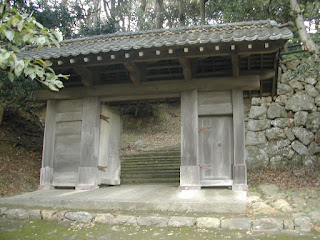Above the stairs, this shrine appeared before my eyes.
Then I came to this gate. This was not the gate of the castle. Someone moved this old gate that used to belong to Tsuwano han. The sign explained that it was transferred to Hamada han. Tsuwano and Hamada han must have been like brothers, not only because of the fate of this gate, but some new information I gathered right before this trip, and luckily, I confirmed it during this trip.
Climbing up these steps was my good exercise. I opened and closed both my palms as I went up. Then I lifted my arms up like a jet plane and rotated my shoulders. I was pretty sure nobody was around.
I loved it although it was a bit cold.
How wonderful it was to reach the top!
This view was on my left.
This was on my right. It was unreal to me. Waves hit the frame of the bay throwing up white splash. The sign there said, in 1626, a Spanish missionary named Diego de S passed this spot. He reported he saw a fine castle. I'm sure the Hamada han's samurai were looking down with their curious eyes. I wonder if any of them went down and said hello.
I've never seen this flower before. I thought it could be from a foreign land.
The ground I walked on was soft, but it was windy. I wanted to stop at one more place, a local research center, if I needed to leave Hamada rather than staying one night. I received a call from the person in charge at the library. She said it would take a long time even if I showed her my family certificates. She probably has never processed this kind of request.
Probably I'll have a chance to step on the beautiful ground like above again. Nothing is in hurry for me. I'm just surprised at anything I've seen.
At the Hamada station, I found only one bakery where I had some sandwich, a sweet, and coffee. The bakery was a part of a hotel. I asked an assistant there if they had a vacancy. They were all booked except one smoking single room. No, thank you. I rather stay at a clean and reasonable business hotel free from cigarette smoke. I found one next to the Shin Yamaguchi station. Looking at these photos, I want to go back there again next year and travel further along Japan Sea.




















8 comments:
This account of your travels is very reminiscent of Bashō, who as you may know is the patron saint of my own blog. I don't suppose I shall ever visit Japan, but your recent posts are the next best thing.
I loved your pictures from your walk, and I smiled when I thought about you climbing those steps, waving your arms around and hoping nobody else was there to see.
I felt a certain level of peace and a acceptance of your personal position within your finds, as I read this account of your travels. The pictures must have had some bearing on the mood that I felt.
The shallow turning steps are a pictorial delight.
Vincent,
I'm glad you like it.
Yes, I read your blog wall. At my first reading, it didn't give me a feel of "The Narrow Road to the Northeast" by Basho because it was written in English, but after a few times, it did. I love especially the beginning. It's an excellent translation.
Kristie,
About my exercise, I do it anyway. Sometimes I stand on my toes in subway. That's a great exercise.
But I was all alone there, and I was free to be a crown. I especially enjoyed rolling my shoulder blades like an airplane.
ZACL,
I'm glad you think so.
Actually those steps were bigger than we see here, and some part, it was quite unreasonable big steps! As I walked up, I felt as though I were a samurai wearing a pair of loose hakama trousers. I worried to soil the bottom of the trousers. Would samurai pull up their trousers like English women's long skirts in 18th century? I always worry about such detail like that. Their skirts or trousers get dirty, and it's difficult to clean later and so on.
The Hamada han before 1836 had different members, and their fate was tragic. The Hamada han after 1836 came from Tatebayashi, and they also encountered hardships and tragedy.
I've been reading some history books related to the Edo period, and I've been mumbling, "So and so didn't need to commit harakiri!" and so on.
Gorgeous photos to compliment a very interesting blog.
Thank you, Ashok!
Post a Comment